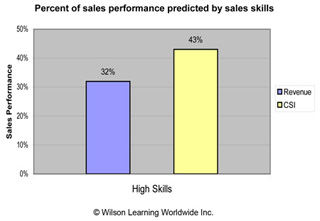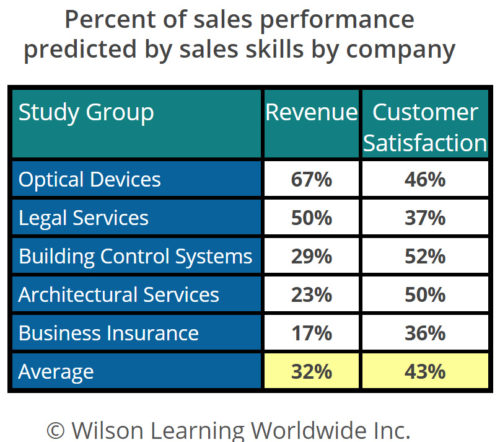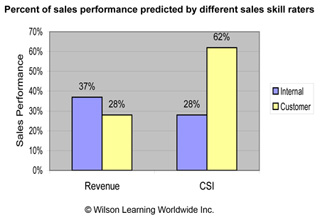Executive Summary
New competitive realities are forcing organizations to reexamine how their sales force contributes to their competitive advantage. This paper reports on research Wilson Learning has done with five separate organizations to define the role of salespeople in creating differentiation and competitive advantage. Work with these companies, representing different industries, shaped our understanding of the competencies required for today’s highly competitive sales environment. Our research shows a 32% increase in top-line performance due to a salesperson’s ability to serve as both a business consultant and business strategist.
Sales as a Source of Competitive Advantage?
In this competitive era, understanding the factors that lead to sales force performance is critical to an organization’s success. Not knowing can have serious consequences: rising cost of business, loss of market share, lost customers, and the expense of supporting low performers.
Over the past several years, Wilson Learning has had the opportunity to work closely with companies to uncover the sources of competitive advantage residing in their salespeople and sales managers; develop techniques for measuring skill levels; develop these critical competencies in their sales forces; and support application of these skills to their customer interactions. We have also collected sales performance data for many of these companies to analyze the impact of these skills on their organization. This paper reports on five of those organizations to independently show how these skills are improving each organization’s financial and customer success. These studies examine organizations that operate in highly competitive environments and have complex sales processes that require advanced consulting and business skills on the part of their sales forces. While the industries are all different, they all provide products and/or services that have multiple components and tend to have longer sales cycles.
In this work, we have come to some important conclusions:
- Effective sales professionals play two complementary roles—business consultant to their clients and business strategist to their own organization.
- Skills in both of these roles are essential to effective sales performance. If either is missing, then overall effectiveness is lower.
- Sales performance is closely tied to the salesperson’s ability to fulfill both of these roles. Depending on the organization, between 17% and 67% of the differences between high and low performers is attributable to differences in these skills.
Consultant and Strategist Skills
A New Era in Selling
In understanding the distinction between the consultant and strategist roles, it is often helpful to examine historically the role of salespeople in creating competitive advantage. In the distant past, the successful salesperson was a “persuader,” a good presenter, and a product/service feature expert. This sales approach suited a market, mostly in the 1950s—1970s, where customers had little information and were eager to buy in an expanding business climate.
In the 1970s and to some degree today, the salesperson as “problem solver” became the sign of success. Salespeople discovered their clients’ needs, aligned their resources to their clients’ problems, and handled buying objections.
For some of our clients, especially those offering highly flexible and complex product offerings, this problem-solver approach was failing to achieve competitive advantage. As we worked with these organizations, a new view of effective sales performance started to emerge. The hallmark of this new approach was that taking a single perspective—either a persuader or problem-solver—was no longer sufficient. Rather, salespeople had to simultaneously wear two hats—the Business Consultant hat and the Business Strategist hat.
The Business Consultant Hat
When a salesperson wears the Business Consultant hat, his or her focus is on providing advantage to the customer. Today’s salespeople need to add value to their customers’ bottom line. They do this by discovering how the selling organization can play a strategic role in the customer’s business, communicating credibly with senior executives, and understanding the customer as a value chain so they can see the sub-optimal steps in the customer’s processes and offer their products as solutions. Salespeople as Consultants establish the value of their solutions in terms of profitability, cost savings, or improved competitiveness.
The Business Strategist Hat
When a salesperson wears the Business Strategist hat, his or her focus is on providing advantage to his or her own organization by selecting high-yield targets and executing winning strategies. Salespeople as Strategists understand that the cost of sale is greatly influenced by their win/loss ratio and make sure that, before pursuing an opportunity, they know that the customer is willing to buy from them, will buy, and will buy soon. A Strategist is not only keenly aware of the competition, but understands his or her competitor’s sales strategies and creates an environment where the competitor’s strengths become their weaknesses. Business Strategists know that, once they choose to pursue an opportunity, they must use all of their ability and resources to win. They also know that it is better to walk away from an opportunity before a large investment in time and resources is made when the chances of winning are slim.
 Sales Effectiveness Model
Sales Effectiveness Model
The Consultant/Strategist Model The roles of Consultant and Strategist are not contradictory; they represent two sides of the same coin—Sales Effectiveness. This is represented by the model at right.
In addition to the Consultant and Strategist roles, the model includes two additional skill sets that we refer to as Personal Effectiveness and Technical Effectiveness. Personal and Technical Effectiveness skills have traditionally been thought of as the most important capabilities of sales professionals and serve an important supportive role to the Consultant and Strategist roles. Personal Effectiveness skills include self-management, innovativeness, and core interpersonal skills. Technical Effectiveness includes the core knowledge components of the job, product knowledge, and basic business acumen. While these skills are critical, and at one time were sufficient for effective sales performance, their primary role is to help make the salesperson a more effective Business Consultant and Strategist.
Proving the Impact of Consultant and Strategist Skills on Performance
Working with organizations to identify a core set of sales skills for creating competitive advantage is one thing, but demonstrating the relationship between these skills and business performance is another. Verifying this relationship is essential if these skills are to become the core of an organization’s sales strategy. Therefore, we worked in partnership with five organizations that met the following criteria:
- They sold products and services with multiple components that could be configured in different ways and tended to have relatively long sales cycles.
- They represented organizations from a broad range of industries.
- We had access, for the study, to all of the organization’s salespeople or a complete division.
- They were willing to share performance data for each of the salespeople involved. For this study, we wanted a performance measure that could be applied relatively universally, so we utilized percent of annual quota achieved.
- They were willing to administer surveys, both within their organization and with their customers, to measure Consultant and Strategist skills and customer satisfaction.
These five clients view our work with them as one of their own sources of strategic advantage; needless to say, we cannot identify who they are or where they operate. However, we can indicate that they all compete in one of three vertical markets: life sciences, professional services, or financial services.
The first phase of our work focused on identifying the Consultant and Strategist skills that predict performance. Within each company there was a broad mix of skill and experience, and we first wanted to discover whether these skills were important to high performance and, if so, which skills were most critical. Therefore, in order to establish this baseline, studies were conducted prior to any additional sales training.
Measuring Sales Performance and Sales Skills
For most organizations, sales performance is multi-dimensional. That is, several outcomes are viewed as important to overall sales performance. To show the full effect of Business Consultant and Strategist skills, we measured two components that all the organizations saw as critical to their definition of sales performance:
- Sales Revenue: We examined sales revenue through the percent of quota each salesperson achieved. This allowed us to compare equitably across the five organizations, where there was a wide range of product costs and average sales price.
- Customer Satisfaction: Many organizations consider customer satisfaction to be at least as important as revenue. Our measures of customer satisfaction predicted things like customer retention, repurchasing, and sales per year. Thus, while independent of the revenue measure, customer satisfaction was measured as an indicator of long-term sales performance.
The studies were all conducted in the same way:
- We created a survey that measured the core sales skills described above. The survey consisted of 34 questions that had previously been assessed as a reliable and valid measure of these skills (more detail on the validation of all the measures is available).
- The surveys were distributed as a 360-degree feedback system. That is, salespeople, sales managers, and customers all completed the surveys.
- The organization provided us with each salesperson’s quota achievement from the previous 12 months.
- Along with the sales skills survey, we distributed a customer satisfaction survey to the customers to generate a Customer Satisfaction Index (CSI). This CSI had also been previously assessed as a reliable and valuable measure of customer satisfaction.
To prove the link between the sales skills and the two measures of performance, we used a technique known as multiple regression analysis. In brief, the analysis results in a percentage (referred to as R2) between 1.00 and 0.00. This number indicates what percent of sales performance can be predicted by knowing the sales skills of the salespeople. The higher the R2, the more impact sales skills have on sales performance.
Findings
 The results of this study provide convincing evidence that the Business Consultant and Strategist skills are a strong predictor of both performance measures. That is, salespeople with greater sales skills had higher revenue and greater customer satisfaction.
The results of this study provide convincing evidence that the Business Consultant and Strategist skills are a strong predictor of both performance measures. That is, salespeople with greater sales skills had higher revenue and greater customer satisfaction.
We cannot show you actual performance measures (both because this was confidential information, and there was wide variety across the five organizations), but we can show the general pattern of results from these five studies. The graph at right shows the percent difference in Revenue and CSI for salespeople with high levels of Consultant and Strategist Skills when compared to salespeople without Consultant and Strategist skills. The high-skills salespeople had 32% higher revenue performance and 43% higher customer satisfaction than did salespeople without these skills.
Differences Across Organizations
There were also interesting differences among the organizations in how much the sales skills predicted the sales performance measures. This information is provided in the table at right. As the table shows, the proportion of revenue accounted for by the sales skills ranged from a high of 67% to a low of 17%, and for customer satisfaction from a high of 52% to a low of 36%.
The optical devices company is an interesting example. In this market, prescription lenses have largely become a commodity, with very little that differentiates manufacturers today. Thus, in many cases, the company relies on its salespeople to be its major, if not only, source of competitive advantage. Given this, it makes sense that such a high proportion of the difference between its highest and lowest performers is tied to their Consultant and Strategist skills.
Different Perspectives on Sales Skills
Another interesting finding was the performance differences related to who was rating the salesperson’s skills.
As described earlier, the sales skill measurement was implemented as a 360-degree feedback system. Therefore, we were able to compare the customers’ views on the skills to the more “internal” view of the skills (that is, ratings by managers and peers). The graph at right shows how well the sales skill ratings predicted the performance measures for the customer and internal ratings separately. While both internal and customer ratings predicted the performance ratings, the internal ratings predicted revenue slightly better than the customer ratings, and the customer ratings predicted customer satisfaction better than the internal ratings.
One explanation for this difference is the relative contribution of the Consultant and Strategist skills in each rating. It is reasonable that peers and managers placed greater emphasis on their ratings of the Strategist skills, while customers placed greater emphasis on the Consultant skills. Thus, this finding lends support to the idea that these two sets of skills are complementary and each contributes uniquely to the sales relationship. If a salesperson has only Consultant skills, he or she may have highly satisfied customers, but because of a focus on providing advantage to the customer, may not sell against competition well. However, if a salesperson has only Strategist skills, his or her sales might go up temporarily, but the focus on providing advantage to his or her own organization will dissatisfy customers in the long term; such customers will turn elsewhere for a salesperson more focused on their strategic needs.
What Are the Critical Sales Effectiveness Development Opportunities?
 While each salesperson had individual strengths and weaknesses, and each organization had differing broad priority development requirements, there were some consistent patterns that are revealing about the general needs of salespeople today. The table at right shows the five sales skills that salespeople performed least effectively across all of the studies. Interestingly, there were critical skills in all four parts of the Sales Effectiveness model.
While each salesperson had individual strengths and weaknesses, and each organization had differing broad priority development requirements, there were some consistent patterns that are revealing about the general needs of salespeople today. The table at right shows the five sales skills that salespeople performed least effectively across all of the studies. Interestingly, there were critical skills in all four parts of the Sales Effectiveness model.
- The first skill, Understanding Customer Critical Success Factors (CSFs), is a Business Consultant skill focused on a salesperson’s ability to gain knowledge of the customer’s critical business processes and the factors critical to their success. This skill, only performed effectively by 45% of the people studied, is necessary for configuring products for customers’ specific needs and positioning the solution as a strategic initiative.
- The second skill, Creating Initial Contact, is a Business Strategist skill focused on the salesperson’s ability to leverage existing relationships and develop sales messages to gain access to senior executives in the client organization. This skill was performed effectively by only 41% of the salespeople.
- The third skill is also a Business Strategist skill. Analyzing Account Success Probability, performed effectively by only 45% of the salespeople, is the ability to analyze a sales opportunity to determine the likelihood of a win early in the sales cycle. The earlier a salesperson can determine the probability of a win, the more he or she can focus resources on winning opportunities, rather than wasting resources on sales campaigns doomed from the beginning.
- The fourth skill, Personal Learning and Development, is a Personal Effectiveness skill, indicating a salesperson’s ability to seek out and acquire new knowledge to help in his or her sales efforts. A salesperson’s willingness and ability to locate client financial and strategic information, or to develop a depth of knowledge in the client’s industry, was the skill performed effectively by the least number of salespeople—only 38%. This is not surprising. Salespeople, as a group, are known for their preference for action and physical activities over more passive, contemplative activities. However, this provides strong evidence that salespeople who do engage in self development activities have greater sales performance.
- The final skill, Applying Financial Acumen, is a Technical Effectiveness skill. This is a measure of the salesperson’s ability to analyze a customer’s financial condition and willingness to purchase the product, based upon examination of key financial reports (P/L statement, balance sheet, cash flow, etc.). Only 41% of the salespeople we studied were effective in this skill.
Conclusion
The results of these studies show the close relationships among sales skills, revenue performance, and customer satisfaction. The study suggests that by developing Business Consultant and Strategist skills in their salespeople, organizations in highly competitive markets could see, on average, a 32% increase in revenue, and maybe as high as a 67% increase.
The study also points out the value of measuring and then developing sales skills. If any of these organizations had provided sales skills training without a deep understanding of which skills were most closely tied to success, they would have developed skills that were less critical than the ones they focused on, and valuable time out of the field may have been wasted. By carefully assessing current skill gaps, and the impact of those gaps on sales performance, development efforts are more targeted and more successful.
By focusing on development of the skills fundamental to performing the role of the Business Consultant and Business Strategist, these organizations were able to effectively improve the performance of their sales force. While the amount of improvement you receive depends on the solutions you offer and the competitiveness of your market, these skills can have the same impact on your organization.

